5 Tips for Catching an Incredible Angkor Wat Sunrise Like a Pro
‘Tuk-tuk, sir? Tomorrow you go see Angkor Wat sunrise?‘
That’s the call of tuk-tuk drivers waiting for business in the temple town of Siem Reap. It’s also one of the most popular and spectacular things to do. Getting the most out of the DIY experience requires planning, however. Forgoing it will only result in stumbling, scuffles with rude tourists, photos of their selfie-sticks and plenty of frustration.
In this post, I’ve put together five tips that will ensure you get the best out of this magical phenomenon and lose the least sleep – all for just $7 more.
Angkor Wat sunrise pro tips
1. Make sure it’s good sunrise weather
This seems obvious but I cannot overstate it. The sky is the most important part of sunrise at Angkor Wat. Trust me, you don’t want to drag yourself out of bed to watch dark grey skies turn light grey, or worse, sit through a thunderstorm inside a stuffy tuk-tuk. Save the effort for a clear or partly cloudy time between 4 and 7 a.m.; there are plenty of apps that have hour-by-hour forecasts.
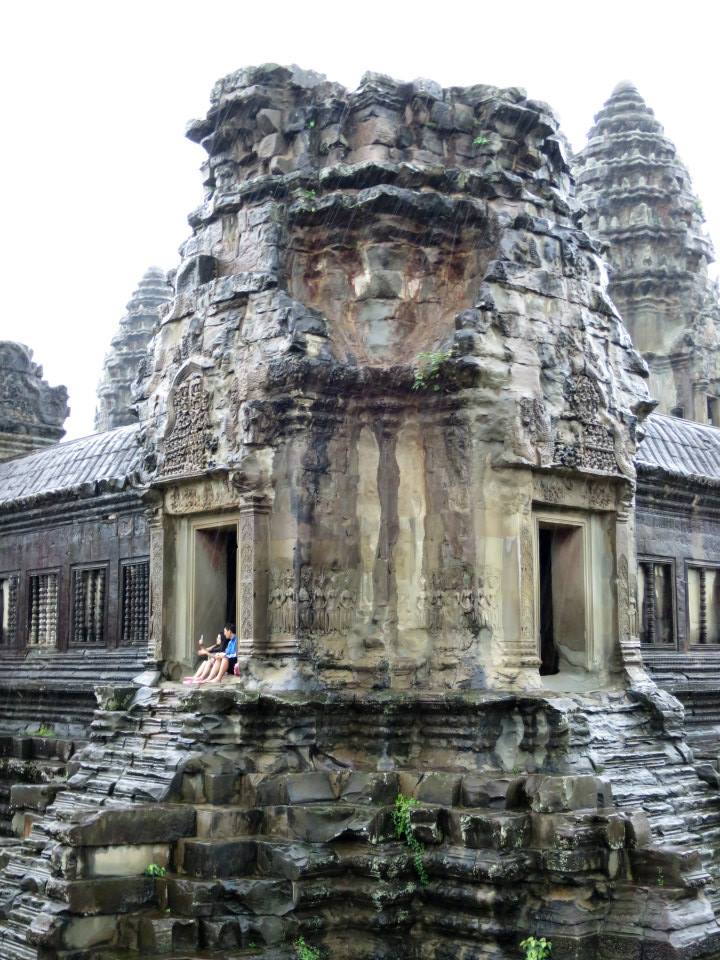
2. Buy your tickets the day before or online
Buying only a single-day pass? The day before your chosen sunrise date, go to the ticket office no earlier than 4.45 p.m. It starts selling tickets that are valid for the next day from 5 p.m. This ensures that you don’t waste any time queuing for your pass in the morning, especially since the office now requires a detour from the main road. Did I mention that your bleary-eyed portrait will be taken and printed on your pass?
If you’re buying a three- or seven-day pass, there’s no need to rush like this unless you want to catch the sunrise on the very first day. By the way, the prices in US dollars are $37 (one day), $62 (any three days out of 10 and they don’t have to be consecutive) and $72 (seven days in a month).
Now you can even purchase your Angkor passes online before you even leave home for your Angkor Wat sunrise adventure. All you need are a digital passport photo and your credit card details. You can show the inspectors at the gates your pass on your phone.
3. Recce the place beforehand
If you get your physical ticket at 5 p.m., you have a free pass to the Angkor Archaeological Park for the rest of the evening. The guards should not punch a hole in your pass. Use the remaining daylight to walk around the inner west side of Angkor Wat and find the ideal spot to take your photos from. The constant restoration works mean that some visible part of the temple will be under scaffolding. The trees are useful for covering the work but you won’t find them in the pre-dawn darkness.
As an added bonus, from February to early September, the late sunset bathes Angkor Wat in a gorgeous golden light. The guards start ushering people out from the inside from 5.30 p.m., so you should be able to hang around the pond for another 15 minutes.
All told, the extra trip in a tuk-tuk to Angkor Wat alone and back should cost $7. Reward yourself with a glass of 50-cent beer and have an early night.
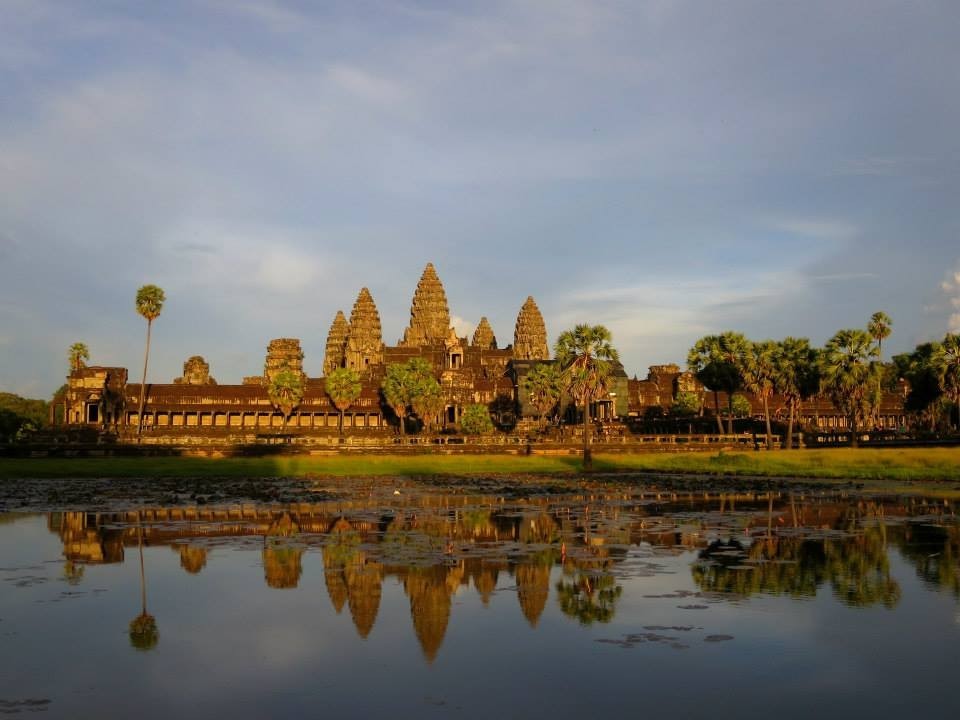
Elsewhere in Southeast Asia: Exploring Bagan on your own
4. Go to the pond on the right if you’re taking photos
Armed with your tickets*, you and your party should be motoring straight to Angkor Wat at 4.30 a.m., with no detours to the ticket office. Remind your driver to take the old road; on the map, it’s Charles de Gaulle and it runs north-south from the southern side of the moat. *You should also have insect repellent, a flashlight and a drink
Most of the photographs of Angkor Wat are taken from the edge of the pond on the left as you enter. (See the photo above.) It’s popular because, from that spot, the sun appears to rise behind the temple. It also gets crowded there very quickly.
I can vouch that the view is no less beautiful from the pond on the right-hand side. In addition, as of November 2016, one of the towers on the left was under scaffolding. If you’re taking photos, it’s easier to hide it using the trees on that side. You should have found all this out the day before, anyway.
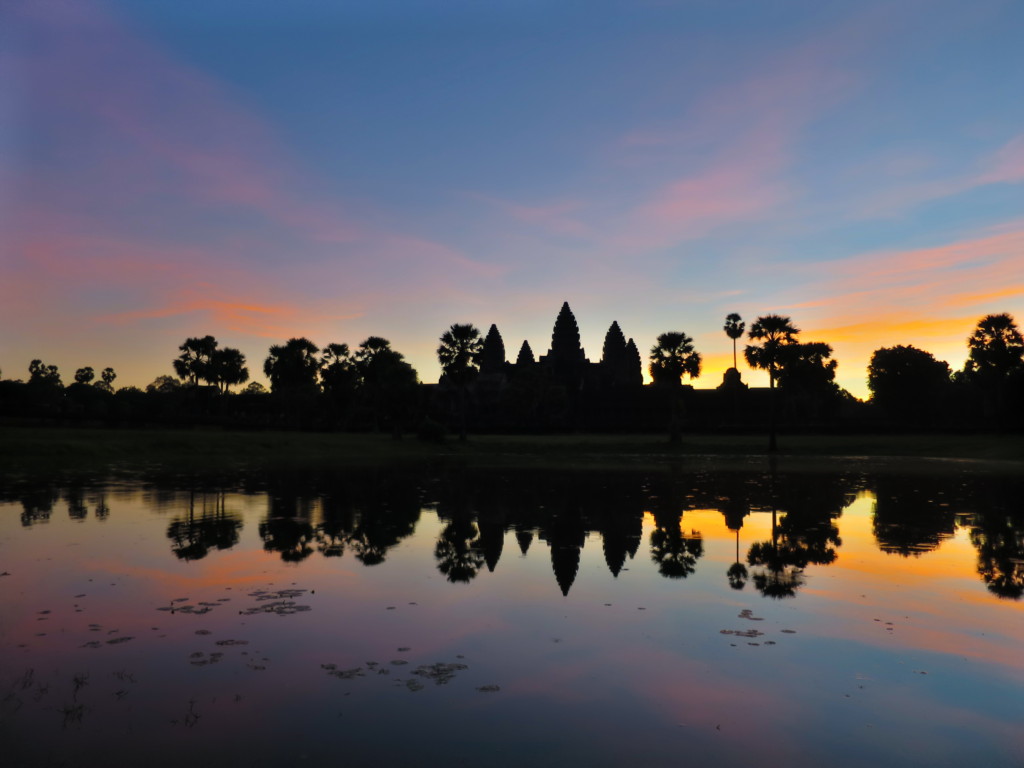
5. Walk right through after the sunrise
Once you’ve had your fill of the sunrise, don’t forget to explore the temple while the temperatures are still low. Very few people venture beyond the relief of The Churning of the Ocean of Milk on the eastern inner wall, but it is worth appreciating the view from the other side. Ten to fifteen minutes after sunrise time, the morning sun lights up the five inner shrines within the inner enclosure.
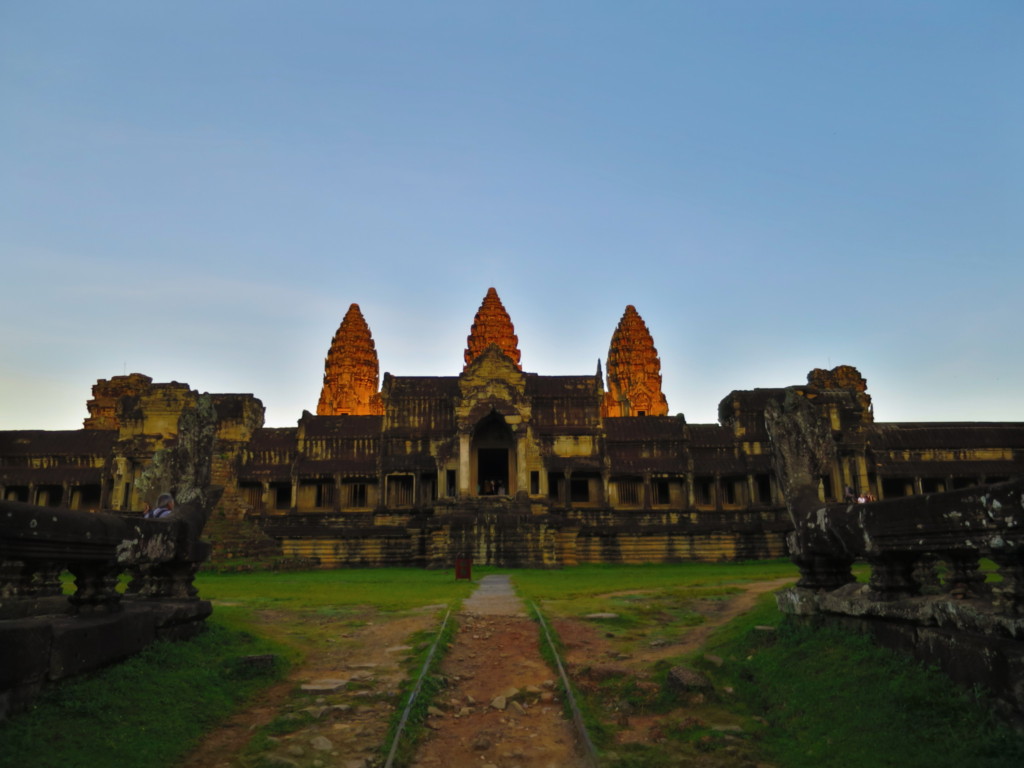
Walk further still and you may find yourself alone for a while. The path is maintained to the barest minimum and the outer enclosure wall is shockingly dilapidated, probably the way it was before Angkor Wat was spruced up.
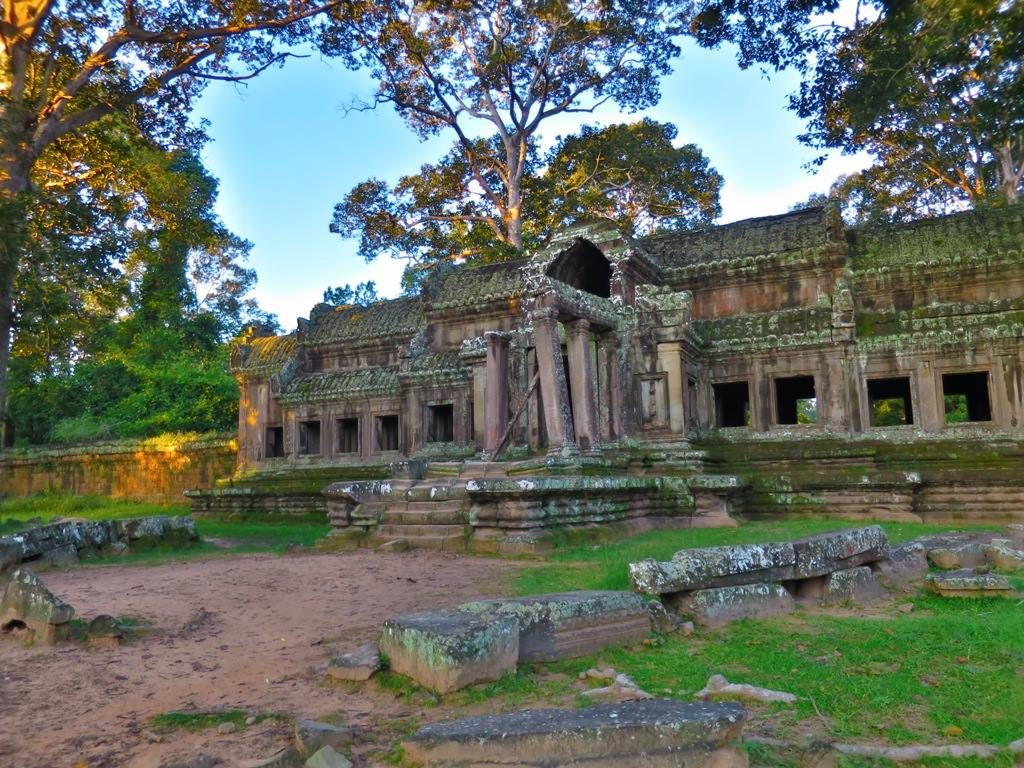
There may or may not be enough time to join the queue to ascend those towers. The line forms very early and quickly and access is limited to a couple of hundred people. If that’s your goal, you may want to save it for another day when you don’t mind skipping the sunrise to queue. However, there’s enough time to catch up on the other bas-reliefs that other people have been poring over. When it’s your turn, you know what to know for, having used the resources in my art student’s perspective post.
If all this doesn’t give you a buzz as you return to town or continue to Angkor Thom, nothing else will. After all, you got to see things and take photos of the Angkor Wat sunrise that 90% of the other visitors didn’t get. Don’t forget to reward yourself with more 50-cent beers for that.
How about sunset? Let me introduce you to Phnom Krom – it’s even better than Phnom Bakheng and Pre Rup. For the next day, consider leaving town for Banteay Srei at 6 a.m.
27/11/2016 @ 2:29 PM
Awesome tips! We took few nice shots of Angkor Wat some time ago and going to the pond on the right was definitely the key tip :).
01/12/2016 @ 7:34 PM
Thanks! You got some good photos from your time there.
18/02/2018 @ 12:51 PM
I have not yet been to Angkor wat so this post is great knowledge for me. At least now I know I should aim for sunrise in Angkor wat, not sure I will do it with tuk tuk. I didnt know we can get ticket one day earlier for the following day visit. This post has good value information for me before I headed to Angkor Wat.
20/02/2018 @ 12:24 AM
There are companies that take tourists in cars and minibuses but sharing a tuk-tuk (which seats four) is the cheapest way to get around without breaking a sweat. You can also cycle there but you have to start very early and there are no street lights in the Angkor zone. :)
25/02/2021 @ 6:26 PM
Why is the old road better?
26/02/2021 @ 5:19 PM
Hi Garry, the old road leads you directly to the south side of Angkor Wat’s outer moat from the centre of Siem Reap. Many people use Apsara Road to get to the ticket office, so most of the congestion happens on that detour.
18/02/2018 @ 8:04 PM
These are great tips for taking photos at Angkor Wat at sunrise. Indeed checking the weather is very important! I was recently at Tikal and I only had one day there. The weather wasn’t great so I didn’t bother waking up early and go for the sunrise tour, knowing that it will be cloudy.
20/02/2018 @ 12:25 AM
But, hey, you got to visit that part of Mexico! *envy* :D I bet the extra sleep was worth it.
18/02/2018 @ 9:32 PM
Very timely tips for us as we’re visiting Angkor Wat in April! Will be bookmarking this article :)
Thanks for sharing!
20/02/2018 @ 12:26 AM
You’re welcome. Please give me a heads-up when you write about it.
18/02/2018 @ 11:55 PM
Nice article. Happy to see those pictures and beautiful place through your blog and thanks for the tips. ? Keep up the good work. Love from Nepal.
20/02/2018 @ 12:28 AM
Thanks! I think my friends will like your rock-climbing post.
19/02/2018 @ 10:54 AM
Great recommendations. I can imagine a lot of people pack the place for perfect picture op, do you have any recommendations for sunrise pics that can be taken differently there?
20/02/2018 @ 12:40 AM
You can try Srah Srang, a reservoir that’s a 20-minute ride to the east. You’ll also need the pass because it’s within the Angkor zone.
19/02/2018 @ 11:42 AM
I am a sunrise person, I loved all the tips here. All are so practical and many a times even followed by me. I visit a place twice once during the day and another during the early morning. Anything for the good views and good pics ;)
20/02/2018 @ 12:43 AM
Thanks, Purvi, you have some great photos too.
19/02/2018 @ 10:44 PM
Cool tips! I’m really hoping to visit Angkor Wat sometime and of course, take cool photos! Your tips will be very helpful when I finally get to visit! I’d definitely check out the views from the pond.. Your photo from there is gorgeous!
20/02/2018 @ 12:45 AM
Thanks, Marvi! When you visit and post your own photos, please let me know so that I can take a look.
20/02/2018 @ 12:37 AM
Excellent tips! I wish I’d seen this before my visit many years ago. If I ever have the chance to visit again I will put these suggestions to good use. But for now I’ll share this with other travelers that are lucky enough to visit the area.
20/02/2018 @ 9:38 AM
Thanks, Melissa :) Siem Reap has changed a lot since then but I’m sure it’ll welcome you back if you decide to return.
20/02/2018 @ 1:17 AM
Thanks for some amazing tips. I especially like the tips about purchasing tickets the day before and then getting access into the park after 5 p.m. The photos from the pond are amazing.
20/02/2018 @ 9:40 AM
The lotuses weren’t blooming like in the postcards, but I’m quite pleased too. :)
21/02/2018 @ 8:36 PM
Such helpful tips! Thanks for sharing. I loveeee your photo by the way – what a pro!
22/02/2018 @ 6:09 PM
Hence, the title ^_^ Cheers!
22/02/2018 @ 5:44 PM
Your photography is amazing! The colours you’ve captured are incredible!
22/02/2018 @ 6:10 PM
Thanks, Marc!
23/02/2018 @ 3:39 AM
Very nice post! the photos especially the sunrise on a clear day wowed me away! Thanks for Sharing :)
12/05/2018 @ 10:14 PM
Here in may 2018 and the ponds near the inner temple are empty or almost so. Appears the for maintenance.